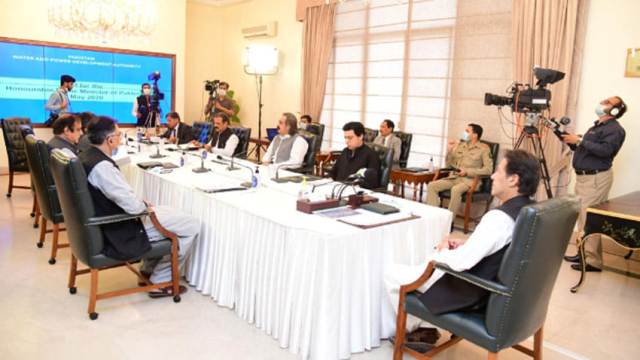 Prime Minister Imran Khan chairs a COVID-19 meeting. [photo: Pakistan Ministry of Information and Broadcasting]
Prime Minister Imran Khan chairs a COVID-19 meeting. [photo: Pakistan Ministry of Information and Broadcasting]
[This is an excerpt from an article in the current edition of The Round Table: The Commonwealth Journal of International Affairs. Opinion pieces do not reflect the perspective of the Round Table Editorial Board.]
That Pakistan does not have the resources to take counter-measures against Covid-19 if it starts spreading at an exponential rate through local transmission is painfully obvious. Pakistan’s public spending on health is less than 1% of GDP, with 80% of the population having to self-fund medical care. The country has more battle tanks and artillery pieces than it has ventilators and functional ICUs. Public hospitals, even in the capital, are grossly underfunded and medical personnel enjoy poor service conditions. While the long-term starvation diet imposed on the health and education sectors is rooted in elite choices about the kind of national political economy to operate, the implications of these choices in the face of the pandemic were obvious to all serious observers by early March. Either Pakistan would implement a lockdown and flatten the contagion curve or it would be flattened by that curve rising uncontrollably.
Between the detection of the first confirmed case on 26 February 2020, and 17 March, the federal government, led by an apparently paralysed prime minister, dithered. Urgent requests for additional funds to purchase equipment were shot down by the Cabinet, and the messaging from the prime minister made it appear that given a choice between protecting lives or livelihoods, the federal government would rather not make a decision. Fortunately, there was more decisive action by the provincial leadership in Sindh, a sense of urgency on part of the Khyber-Pakhtunkhwa government, and intervention by the armed forces. Since then, the response of the Pakistani government has coalesced around four major policy planks.
First, the government has moved towards as complete a lockdown as possible with movement between localities restricted to essential services and commodities. Air, rail, and inter-city bus travel are practically suspended barring exemptions granted for special cases and the disbursement of aid. Enforcement of the lockdown has been generally successful, though some hard-line clerics have defied the government’s ban on public gatherings.
Second, the government has extended the scope of Pakistan’s income support programme, deferred tax collection, and launched an economic stimulus amounting in total to about 2% of GDP. Some 900 USD million are to be disbursed to 12 m households under the Ehsaas Emergency Cash Program (EECP). More will be needed as exports are expected to halve and revenue collection projected to contract by one-third by 30 June 2020. The battering that Pakistan’s anaemic economy has taken has also led to the prime minister calling for debt relief from foreign creditors. Public works programmes are being revved up to provide labour with some employment during the economic downturn.
Third, since Pakistan has only conducted about 60,000 tests for Covid-19, the 5000+ confirmed cases might not be providing an accurate picture of how far the virus has spread. In addition to the national and provincial restrictions on movement, local administrations are enforcing additional quarantine measures on neighbourhoods where cases are confirmed. These measures are unpopular and as the risk of local backlash is significant they may prove difficult to sustain.
Fourth, the government is urgently trying to procure and disburse personal protection equipment (PPE), testing kits and ventilators. This has proven challenging given the rising demand for them. Medical staff in Balochistan who protested against the lack of PPE were rounded up by the police and briefly detained; in Islamabad, doctors are having to self-provide such gear.
Covid-19 has highlighted the many vulnerabilities and inequities in Pakistan. Neglect of health, education, housing, sanitation, and formalisation of the workforce has left two-thirds of Pakistanis acutely exposed to the economic effects of the pandemic. The harshness of the structural adjustment policies imposed on successive governments by Pakistan’s creditors since the 1980s has contributed to the hollowing out of public sector capacity, failed to improve market efficiency or competitiveness, and left Pakistan with a gravely weakened state and economy. Inflexible debt and defence burdens, combined with a neo-liberal obsession with avoiding budget deficits, have crippled public policy discourse and decision-making.
Ironically, this is where the silver lining might just lie.
Ilhan Niaz is an Associate Professor, History at Quaid-i-Azam University, Islamabad, Pakistan.



